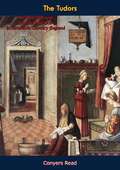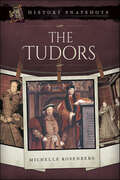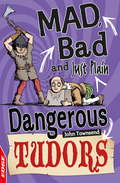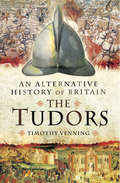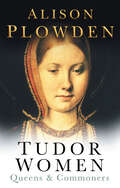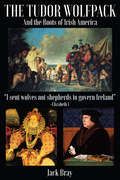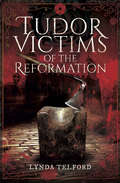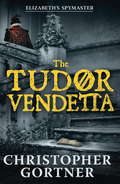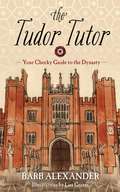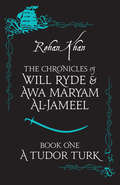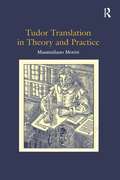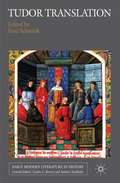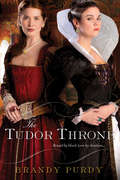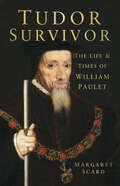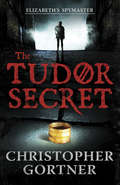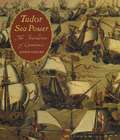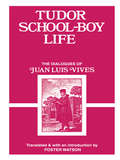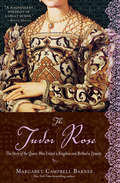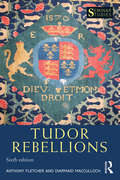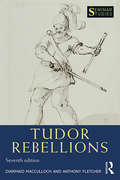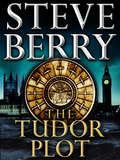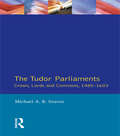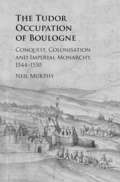- Table View
- List View
The Tudors: Personalities and Practical Politics in Sixteenth Century England
by Conyers ReadFirst published in 1936, author Conyers Read’s The Tudors provides a brief survey of the history of England under the Tudors during the sixteenth century. It will appeal to students of courses in English history or English literature and general history buffs alike.Beautifully illustrated with black & white portraits.
The Tudors (History Snapshots)
by Michelle RosenbergDiscover more about the famous Tudor monarchs, from Henry VII to Elizabeth I.Everything you never knew about the powerful Tudor dynasty - from Henry VII to the glorious Elizabeth I. From Battles at Bosworth to battles for supremacy of the royal bedchamber, marriage, war, murder, divorce, religious dissent, Renaissance letters, science and art, political alliances, the Reformation, treason, a Virgin Queen, phantom pregnancies, global exploration, bloody beheadings and a fresh look at why Henry VIII became such a terrifying tyrant.
Tudors (EDGE: Mad, Bad and Just Plain Dangerous #2)
by John TownsendTime to take a sideways look at the bizarre and outrageous from throughout history - and it's all TRUE!Which mad cure involved swallowing live frogs?Which bad ruler had the most heads chopped off at the Tower of London?Which Tudor invention do we still use today to get rid of dangerous waste?Find out the answers to these questions inside, along with lots of facts, quizzes, and other bonkers stuff as you take a bumpy journey into the darkest crannies of Tudor history with Mad, Bad and Just Plain Dangerous!
The Tudors: An Alternative History of Britain (An\alternative History Of Britain Ser.)
by Timothy VenningA renowned historian examines some of the most crucial junctions of fifteenth- and sixteenth-century Britain—and how they could have gone differently. Timothy Venning&’s series of alternative histories explores the pathways of British events from the Anglo-Saxon Age to the English Civil War. In this volume, he presents an in-depth analysis of the Tudor period. As always, Venning discusses the fateful moments at which History could easily have taken a different turn. In a fascinating series of &“what if&” scenarios, Venning presens a detailed look at the possible and likely results. While necessarily speculative, the scenarios are all highly plausible and rooted in a firm understanding of actually events and their context. In so doing, Venning gives the reader a clearer understanding of the factors at play and why things happened the way they did, as well as a tantalizing view of what might have been. Key questions discussed in this volume include: Did the pretenders Lambert Simnel and Perkin Warbeck ever have a realistic chance of a successful invasion/coup? If Henry Fitzroy, Henry VIIIs illegitimate son, had not died young, might he have been a suitable King? What if Edward VI had not died at fifteen but reigned into the 1560s and 70s? How might the Spanish Armada have succeeded in landing an army in England, and with what likely outcome?
Tudor Women: Queens and Commoners
by Alison PlowdenThe Tudor era belongs to its women. No other period of English history has produced so many notable and interesting women, and into other periods have they so powerfully influenced the course of political events. Mary Tudor, Elizabeth I and, at moments of high drama, Mary Queen of Scots dominated the political scene for more than half a century, while in the previous fifty years Henry VIII's marital escapades brought six more women to the centre of attention. In this book the women of the royal family are the central characters; the royal women set the style and between them they provide a dazzling variety of personalities as well as illustrating almost every aspect of life as it affected women in Tudor England. We know what they ate, how they dressed, the books they read and the letters they wrote. Even the greatest of them suffered the universal legal and physiological disabilities of womanhood - some survived them, some went under. Now revised and updated, Alison Plowden's beautifully written account of the women behind the scenes and at the forefront of sixteenth-century English history will be welcomed by anyone interested in exploring this popular period of history from the point of view of the women who made it.
The Tudor Wolfpack: And the Roots of Irish America
by Jack Bray“The gripping story of the wolves the British sent to govern the Irish . . . Miracles abound in this action-packed history.” —Kathleen Kennedy Townsend, Former Lieutenant Governor of Maryland “The Irish people have suffered mercilessly at the hands of conquerors over the past thousand or so years . . . The Normans tried with only limited success to conquer the Irish in 1167, a hundred years after their takeover of England . . . Irish resistance to British rule provoked a lengthy war between the clans of the Irish chieftains and the English soldiers . . . They confiscated the lands once more and instituted such harsh and outrageous controls that it ultimately resulted in the great Irish emigration to the United States. Jack Bray tells this thrilling story from an immense wealth of knowledge and such a writer’s eye for detail that no one even remotely interested in the period will want to miss it.” —from the Foreword by Winston Groom, New York Times–bestselling author of Forrest Gump“The Irish are a storytelling people and Jack Bray is one of them. And what a story he has written: the centuries of tragedy ending in the building of a great country across the sea, America. Deeply researched and deeply felt, The Tudor Wolfpack and the Roots of Irish America has a brave and musical heart.” —Richard Reeves, national bestselling author of President Kennedy: Profile of Power “Combining the soul of Ireland’s ancient storytelling seanchaí with the great talent and skill of an American lawyer-historian, Jack Bray tells a powerful story about the military conquest and colonization of Ireland in the sixteenth and seventeenth centuries.” —Edward J. Markey, United States Senator, Massachusetts
Tudor Victims of the Reformation
by Lynda TelfordThis book describes a selection of people caught up in the turmoil that presaged the reformation - a period of change instigated by a king whose desire for a legitimate son was to brutally sweep aside an entire way of life. The most famous and influential of the victims were the two people closest to Henry VIII. His mentor, Cardinal Thomas Wolsey, a great churchman and a diplomat of consummate skill. The other was to be the Kings second wife, Anne Boleyn. These two adversaries, equally determined to succeed, had risen above the usual expectations of their time. Wolsey, of humble birth, became a price of the church, enjoying his position to the full, before coming into conflict with a woman who had no intention of being another passing fancy for the king. She would become the mother of one of the greatest and most famous of Englands monarchs. They were brought down by the factions surrounding them and the selfish indifference of the man they thought they could trust. Though they succumbed to the forces aligned against them, their courage and achievements are remembered, and their places in history assured.
The Tudor Vendetta (The\elizabeth I Spymaster Chronicles #Bk. 3)
by Christopher GortnerNovember, 1558: Elizabeth I has ascended the throne but the first days of her reign are already fraught with turmoil, the kingdom weakened by past strife and her ability to rule uncertain. When Brendan Prescott, her intimate spy, returns to court at the new queen's behest, he soon finds himself thrust into a deadly gambit against his old foe, Robert Dudley. But Elizabeth has an even more dangerous assignation in store for him when her favoured lady-in-waiting, Lady Parry, vanishes in Yorkshire. Sent from court to a crumbling manor that may hold the key to Lady Parry's disappearance, Brendan becomes the quarry of an elusive stranger with a vendetta- one that could expose both Brendan's own secret past and a long-hidden mystery that will bring about Elizabeth's doom.
The Tudor Tutor: Your Cheeky Guide to the Dynasty
by Barb AlexanderFrom the bloody Wars of the Roses to Queen Elizabeth I’s iconic rule, the Tudor Dynasty was a period of sex, scandal, and intrigue. Monarchs such as Henry VIII and Queen Elizabeth I have become a part of modern pop culture, resulting in endless parodies, satires, rumors, and urban legends that grace our television screens. But like all urban legends and parodies, facts surrounding the lives of these rulers are greatly exaggerated. In this entertaining guide, Barb Alexander serves to debunk those rumors and educate you about the dynasty. History doesn’t have to be dry, boring, and difficult to read. As an educator, Barb knows exactly how to engage an audience. This pocket-sized guide is not only informative, but also filled with cheek, snark, and wit. With 50 beautiful illustrations that depict Tudor monarchs and key players during their rule, this book is guaranteed to garner a chuckle or two. So sit back, relax, and enjoy the lesson. Before long, you’ll be sharing Tudor history facts that will be sure to impress your less informed peers. Skyhorse Publishing, as well as our Arcade imprint, are proud to publish a broad range of books for readers interested in history--books about World War II, the Third Reich, Hitler and his henchmen, the JFK assassination, conspiracies, the American Civil War, the American Revolution, gladiators, Vikings, ancient Rome, medieval times, the old West, and much more. While not every title we publish becomes a New York Times bestseller or a national bestseller, we are committed to books on subjects that are sometimes overlooked and to authors whose work might not otherwise find a home.
A Tudor Turk (The Chronicles of Will Ryde & Awa Maryam)
by Rehan KhanIstanbul, 1591: the mighty Sultan Murad III has been robbed! The Staff of Moses, used at the parting of the Red Sea, has been stolen from his private collection of religious artifacts in the Topkapi Palace—and the furious Sultan wants it back. To track down the thieves, an elite band of hand-picked warriors is assembled. Among them is Awa, daughter of a noble family form West Africa, and friend Will—kidnapped from London slums at the age of five and now a seasoned and fearless young soldier. The warriors' task is to bring the Staff home—or not come home at all. Their urgent quest takes them from the domed roofs of Ottoman Istanbul, along the crowded canals of Venice, and all the way to the court of Queen Elizabeth 1—in rainy England—in what becomes a daring Mission (almost) Impossible for the 16th century.
Tudor Translation in Theory and Practice
by Massimiliano MoriniFilling a gap in the study of early modern literature, Massimiliano Morini here exhaustively examines the aims, strategies, practice and theoretical ideas of the sixteenth-century translator. Morini analyzes early modern English translations of works by French and Italian essayists and poets, including Montaigne, Castiglione, Ariosto and Tasso, and of works by classical writers such as Virgil and Petrarch. In the process, he demonstrates how connected translation is with other cultural and literary issues: women as writers, literary relations between Italy and England, the nature of the author, and changes in the English language. Since English Tudor writers, unlike their Italian contemporaries, did not write theoretical treatises, the author works empirically to extrapolate the theory that informs the practice of Tudor translation - he deduces several cogent theoretical principles from the metaphors and figures of speech used by translators to describe translation. Employing a good blend of theory and practice, the author presents the Tudor period as a crucial transitional moment in the history of translation, from the medieval tradition (which in secular literature often entailed radical departure from the original) to the more subtle modern tradition (which prizes the invisibility of the translator and fluency of the translated text). Morini points out that this is also a period during which ideas about language and about the position of England on the political and cultural map of Europe undergo dramatic change, and he convincingly argues that the practice of translation changes as new humanistic methods are adapted to the needs of a country that is expanding its empire.
Tudor Translation
by Fred SchurinkLeading scholars from both sides of the Atlantic explore translations as a key agent of change in the wider religious, cultural and literary developments of the early modern period, and restore translation to the centre of our understanding of the literature and history of Tudor England.
The Tudor Throne
by Brandy PurdyIn the wake of King Henry VIII's death, England's throne is left in a precarious state-as is the peculiar relationship between his two daughters. Mary, the elder, once treasured, had been declared a bastard in favor of her flame-haired half-sister, Elizabeth, born of the doomed Anne Boleyn. Yet the bond between the sisters was palpable from the start. Now reinstated, Mary eventually assumes her place as queen. But as Mary's religious zeal evolves into a reign of terror, young Elizabeth gains the people's favor. Gripped by a tormenting paranoia, Mary is soon convinced that her beloved Elizabeth is in fact her worst enemy. And the virginal Elizabeth, whose true love is her country, must defy her tyrannical sister to make way for a new era...A brilliant portrait of the rule of "Bloody Mary" and her intricate relationship with Elizabeth I, the adored "Virgin Queen," here is a riveting tale of one family's sordid and extraordinary chapter in the pages of history. Praise for Brandy Purdy and The Boleyn Wife"Recommended for readers who can't get enough of the Tudors and have devoured all of Philippa Gregory's books." --Library Journal
Tudor Survivor: The Life and Times of Courtier William Paulet
by Margaret ScardWilliam Paulet was the ultimate courtier. For an astonishing 46 years he served at the courts of Henry VIII, Edward VI, Mary and Elizabeth and was one of the men responsbile for introducing the changes in religious, economic and social issues which shaped England as we know it today. He was a judge at the trials of Fisher, More and the alleged accomplices of Anne Boleyn, and though born a commoner, by his death he was the senior peer in England and, as Lord High Treasurer, he held one of the most influential positions at court. With his long and varied career within the royal household and in government, a study of Paulet presents an excellent opportunity to look in more detail at courtly life, allowing the reader an understanding of how he spent his working day. Tudor Survivor is the biography of the man who defined the role of courtier, but also gives valuable insight into everyday life, from etiquette and bathing, to court politics and the monarchs themselves. When asked how he had managed to survive so long, Paulet replied 'By being a willow, not an oak.'
The Tudor Secret (The\elizabeth I Spymaster Chronicles #Bk. 1)
by Christopher GortnerSummer 1553: A time of danger and deceit. Brendan Prescott, an orphan, is reared in the household of the powerful Dudley family. Brought to court, Brendan finds himself sent on an illicit mission to the King’s brilliant but enigmatic sister, Princess Elizabeth. But Brendan is soon compelled to work as a double agent by Elizabeth’s protector, William Cecil—who promises in exchange to help him unravel the secret of his own mysterious past. A dark plot swirls around Elizabeth's quest to unravel the truth about the ominous disappearance of her seriously ill brother, King Edward VI. With only a stable boy and Elizabeth's lady-in-waiting at his side, Brendan plunges into a ruthless gambit of half-truths, lies, and murder. Filled with the intrigue and pageantry of Tudor England, THE TUDOR SECRET is the first book in the Elizabeth's Spymaster series.
Tudor Sea Power: The Foundation of Greatness
by David ChildsIn the sixteenth century England turned from being an insignifcant part of an offshore island into a nation respected and feared in Europe. This was not achieved through empire building, conquest, large armies, treaties, marriage alliances, trade or any of the other traditional means of exercising power. Indeed England was successful in few of these. Instead she based her power and eventual supremacy on the creation of a standing professional navy which firstly would control her coasts and those of her rivals, and then threaten their trade around the world. This emergence of a sea-power brought with it revolutionary ship designs and new weapon-fits, all with the object of making English warships feared on the seas in which they sailed. Along with this came the absorption of new navigational skills and a breed of sailor who fought for his living. Indeed, the English were able to harness the avarice of the merchant and the ferocity of the pirate to the needs of the state to create seamen who feared God and little else. Men schooled as corsairs rose to command the state's navy and their background and self-belief defeated all who came against them. This is their story; the story of how seizing command of the sea with violent intent led to the birth of the greatest seaborne empire the world has ever seen.
Tudor School Boy Life: The Dialogues Of Juan Luis Vives
by Juan Luis VivesFirst published in 1970. Routledge is an imprint of Taylor & Francis, an informa company.
The Tudor Rose Trilogy Collection: At the King's Command\The Maiden's Hand\At the Queen's Summons
by Susan WiggsTravel back to the glittering Tudor court with #1 New York Times bestselling author Susan Wiggs in her beloved Tudor Rose Trilogy.AT THE KING’S COMMANDFrustrated by his own failures at matrimony, King Henry VIII punishes insolent nobleman Stephen de Lacey by commanding him to marry the vagabond woman caught stealing his horse. But what begins as a mockery of a marriage ultimately blossoms into deepest love.THE MAIDEN’S HANDWhen roguishly handsome Oliver de Lacey enters the life of Protestant rebel Mistress Lark, their fates become inextricably bound together in a struggle against royal persecution. As they fight for justice, both Oliver and Lark discover a love worth saving…even dying for.AT THE QUEEN’S SUMMONSFeisty orphan Pippa de Lacey lives by wit and skill as a London street performer. But when her sharp tongue gets her into serious trouble, she throws herself upon the mercy of Irish chieftain Aidan O’Donoghue, and their unlikely alliance reverberates with desire.Titles originally published in 2009.
The Tudor Rose
by Margaret Campbell BarnesOne woman holds the key to England's most glorious empire in this intimate retelling of the launch of the Tudor dynastyA magnificent portrait of Elizabeth of York, set against the dramatic background of fifteenth century England. Elizabeth, the only living descendant of Edward IV, has the most valuable possession in all of England-a legitimate claim to the crown. Two princes battle to win Britain's most rightful heiress for a bride and her kingdom for his own. On one side is her uncle Richard, the last Plantagenet King, whom she fears is the murderer of her two brothers, the would-be kings. On the other side is Henry Tudor, the exiled knight. Can he save her from a horrifying marriage to a cut-throat soldier?Thrust into the intrigue and drama of the War of the Roses, Elizabeth has a country within her grasp-if she can find the strength to unite a kingdom torn apart by a thirst for power. A richly drawn tale of the woman who launched one of the most dramatic dynasties England has ever seen, The Tudor Rose is a vibrant, imaginative look at the power of a queen.
Tudor Rebellions
by Anthony Fletcher Diarmaid MacCullochTudor Rebellions, now in its sixth edition, gives a chronological account of the major rebellions against the Tudor monarchy from the reign of King Henry VII until the death of Queen Elizabeth I in 1603. It also throws light on some of the main themes of Tudor history, including the dynasty’s attempt to bring the north and west under the control of the capital, the progress of the English Reformation and the impact of inflation, taxation and enclosure on society. This new edition has been thoroughly revised to take into account the exciting and innovative work on the subject in recent years and bring the historiographical debates right up to date. It now includes additional documents and extended discussions to bring to life the complex events and politics of the rebellions. The primary sources, alongside a narrative history, allow students to fully explore these turbulent times, seeking to understand what drove Tudor people to rebel and what sort of people were inclined to do so. In doing so, the book considers both ‘high’ and ‘low’ politics, and the concerns of both the noble and the unprivileged in Tudor society. With supplementary materials including a chronology, who’s who and guide to further reading along with maps and images, Tudor Rebellions is an invaluable resource for all students of Tudor history.
Tudor Rebellions (Seminar Studies)
by Diarmaid MacCulloch Anthony FletcherTudor Rebellions, now in its seventh edition, gives a chronological account of the major rebellions against the Tudor monarchy in England from the reign of King Henry VII until the death of Queen Elizabeth I in 1603. The book throws light on some of the main themes of Tudor history, including the dynasty’s attempt to bring the north and west under the control of the capital, the progress of the English Reformation and the impact of inflation, taxation and enclosure on society, and makes comparisons with the other Tudor realm of Ireland. This new edition has been revised once more to take into account the exciting and innovative work on the subject in recent years and bring the historiographical debates right up to date. The primary sources, alongside the narrative history, allow students to fully explore these turbulent times, seeking to understand what drove Tudor people to rebel and what sort of people were inclined to do so. In doing so, the book considers both ‘high’ and ‘low’ politics, and the concerns of both the noble and the unprivileged in Tudor society. With supplementary materials including a chronology, who’s who and guide to further reading along with a selection of maps and images, Tudor Rebellions is an invaluable resource for all students of Tudor history.
Tudor Queenship
by Alice Hunt Anna WhitelockThis book brings together a selection of recent, cutting-edge research which, for the first time, challenges commonplace arguments about Mary and Elizabeth's relative successes or failures in order to rethink Tudor queenship.
The Tudor Plot: A Cotton Malone Novella (Cotton Malone)
by Steve BerryIn this original eBook novella by the New York Times bestselling author of The King's Deception, globetrotting intelligence agent Cotton Malone is lured into dangerous intrigue surrounding the world's most famous royals--and uncovers a murderous conspiracy of terrorists and traitors, all born from an ancient tale of Saxon history. In England to participate in the trial of suspected international terrorists, Justice Department agent Cotton Malone is mysteriously summoned to an audience with the Queen of England. A cryptic call has warned of looming danger to the ailing queen's son and grandson--the next two heirs in line for the throne. And when the source of that ominous information, a notorious tabloid publisher, dies mysteriously, the royal family has reason to fear a genuine conspiracy. But they also suspect that the enemy lies within--and no one at Buckingham Palace, or even the nation's own Secret Intelligence Service, can be trusted. Now it's up to Malone to discover the truth. Matching wits with a power-mad politician and a vicious royal blue blood, he must race against time through the streets of London to the forbidden reaches of Iceland, all to stop a monstrous plot to seize the monarchy--one that stretches back to the time of Arthur.
Tudor Parliaments,The Crown,Lords and Commons,1485-1603 (Studies In Modern History)
by Michael A.R. GravesThis excellent short survey looks at the workings of parliament under the first four Tudor monarchs. After an introductory first section which looks at parliament's medieval origins, the author then considers all aspects of early parliamentary history - including the historiography of the early Tudor parliaments, membership and attendance, the legislative roles of the Lords and Commons and the specific parliaments themselves.
The Tudor Occupation of Boulogne: Conquest, Colonisation and Imperial Monarchy, 1544–1550
by Neil MurphyIn 1544, Henry VIII led the largest army then ever raised by an English monarch to invade France. This book investigates the consequences of this action by examining the devastating impact of warfare on the native population, the methods the English used to impose their rule on the region (from the use of cartography to the construction of fortifications), as well as the development of English colonial rule in France. As Murphy explores the significance of this major financial and military commitment by the Tudor monarchy, he situates the developments within the wider context of English actions in Ireland and Scotland during the mid-sixteenth century. Rather than consider the plantations established in the mid-sixteenth century Ireland as the 'laboratory' for a new form of empire, this book argues that they should be viewed along with the Boulogne venture as the English crown's final attempt to establish colonies through the use of state resources alone.
